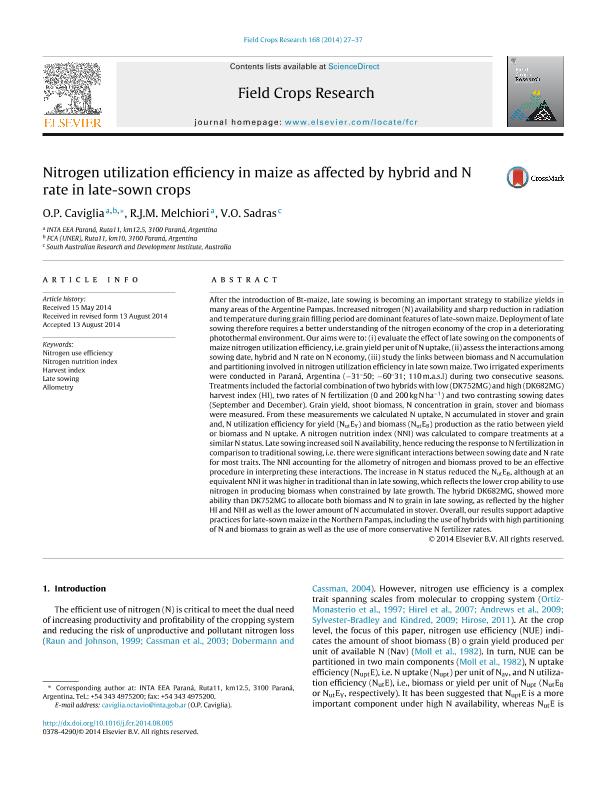Artículo
Nitrogen utilization efficiency in maize as affected by hybrid and N rate in late-sown crops
Fecha de publicación:
11/2014
Editorial:
Elsevier Science
Revista:
Field Crops Research
ISSN:
0378-4290
Idioma:
Inglés
Tipo de recurso:
Artículo publicado
Clasificación temática:
Resumen
After the introduction of Bt-maize, late sowing is becoming an important strategy to stabilize yields in many areas of the Argentine Pampas. Increased nitrogen (N) availability and sharp reduction in radiation and temperature during grain filling period are dominant features of late-sown maize. Deployment of late sowing therefore requires a better understanding of the nitrogen economy of the crop in a deteriorating photothermal environment. Our aims were to: (i) evaluate the effect of late sowing on the components of maize nitrogen utilization efficiency, i.e. grain yield per unit of N uptake, (ii) assess the interactions among sowing date, hybrid and N rate on N economy, (iii) study the links between biomass and N accumulation and partitioning involved in nitrogen utilization efficiency in late sown maize. Two irrigated experiments were conducted in Paraná, Argentina (−31°50; −60°31; 110 m.a.s.l) during two consecutive seasons. Treatments included the factorial combination of two hybrids with low (DK752MG) and high (DK682MG) harvest index (HI), two rates of N fertilization (0 and 200 kg N ha−1) and two contrasting sowing dates (September and December). Grain yield, shoot biomass, N concentration in grain, stover and biomass were measured. From these measurements we calculated N uptake, N accumulated in stover and grain and, N utilization efficiency for yield (NutEY) and biomass (NutEB) production as the ratio between yield or biomass and N uptake. A nitrogen nutrition index (NNI) was calculated to compare treatments at a similar N status. Late sowing increased soil N availability, hence reducing the response to N fertilization in comparison to traditional sowing, i.e. there were significant interactions between sowing date and N rate for most traits. The NNI accounting for the allometry of nitrogen and biomass proved to be an effective procedure in interpreting these interactions. The increase in N status reduced the NutEB, although at an equivalent NNI it was higher in traditional than in late sowing, which reflects the lower crop ability to use nitrogen in producing biomass when constrained by late growth. The hybrid DK682MG, showed more ability than DK752MG to allocate both biomass and N to grain in late sowing, as reflected by the higher HI and NHI as well as the lower amount of N accumulated in stover. Overall, our results support adaptive practices for late-sown maize in the Northern Pampas, including the use of hybrids with high partitioning of N and biomass to grain as well as the use of more conservative N fertilizer rates.
Archivos asociados
Licencia
Identificadores
Colecciones
Articulos(SEDE CENTRAL)
Articulos de SEDE CENTRAL
Articulos de SEDE CENTRAL
Citación
Caviglia, Octavio Pedro; Melchiori, R. J. M.; Sadras, Victor Oscar; Nitrogen utilization efficiency in maize as affected by hybrid and N rate in late-sown crops; Elsevier Science; Field Crops Research; 168; 11-2014; 27-37
Compartir
Altmétricas




